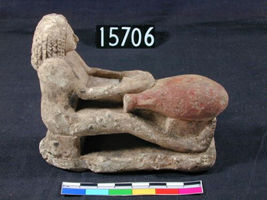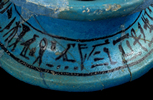
The ancient Egyptian word hemut is translated as 'art' in some contexts, 'craft' in others.
The hemutyu 'people employed in hemut' are always men, in surviving written and pictorial sources.
There are few explicit divisions of hemutyu into different groups, but we find two possible clues towards the definition of hemut.:
professions in the Satire of Trades
'sections' of artists/craftsmen in late Middle Kingdom (about 2025-1700 BC) administration
The Middle Kingdom composition known in Egyptology as the Satire of Trades records the hardships suffered by manual workers. However, though it includes craftsmen such as basket-weavers and potters as well as sculptors and jewellers, it refers to professions (using the word iat) rather than hemut. So it does not prove that the ancient Egyptian literate elite considered pottery or weaving as 'art'.
The following nineteen professions are included in the Satire of Trades:
 |
These are contrasted with the profession of 'writer' (usually rendered 'scribe' in Egyptology). The meaning of 'writer' as profession is not defined. The profession may denote primarily those who worked in the national (royal) administration as writers. It is possible, though, that it included the 'draughtsman', as that title is in Egyptian the compound phrase 'writer of outlines' - the same verb (sS) is used in Egyptian for 'to write' and 'to paint'. The central purpose of the Satire of Trades is to emphasise that the 'writer' has a life of luxury relative to the manual professions.
'Sections' of artists/craftsmen in late Middle Kingdom administration
The late Middle Kingdom witnessed an exceptionally precise style of designating the official positions held by individuals (again using, in some contexts at least, the word iat). Several of these tightly expressed designations incorporate the word waret 'section',on the model 'overseer of the section of goldsmiths'. The surviving and published sources include nine such sections, all referring to a group of workers entrusted with commodities of high material value - metal (tools) and, in one instance, cloth (linen production being one of the principal industries of ancient Egypt). In eight of the nine cases, these workers are craftsmen. These offer a preliminary guide to the ancient Egyptian administration of art, and so, though only indirectly, to an implicit definition of art by the ancient Egyptian literate elite: note though that the surviving record is extremely broken.
The sections (Egyptian waret) for whom overseers are attested in late Middle Kingdom sources:
|
|
 |
The first of these sections underpins most if not all of the rest: the draughtsman is necessary for creating outlines of figures and other compositional elements according to the correct proportions (see the page on guidelines and grids for the variations in proportions across the three thousand years in which ancient Egyptian formal art was in use). The basic tool of the draughtsman is the reed brush; unfinished compositions indicate that his main pigments are red ochre, for the first outline, and carbon black, for the revised or corrected version.
Leaving aside the laundrymen (who would have needed to be controlled because they were handling valuable cloth), the other sections have perhaps one principal shared element: a tool with pointed metal blade. This tool may have been used more in the finishing of a work: for example, a faience figure might be made with a mould, but a fine point would be used application of details before firing. These sections involve craftsmen whose work might have included figurative depictions; although there is no evidence from the late Middle Kingdom, even the sandalmakers might have had to add figures, in the case of production of shoes for the king, as New Kingdom (about 1550-1069 BC) examples include images of foreigners
This would agree with the Satire of Trades, section 5, where hemuu 'craftsman' seems to be defined in a qualifying phrase in the combination hemuu neb tjay anet 'any craftsman who wields a blade'.
The sections along with that of draughtsmen, offer an implicit definition of figurative formal art by the criterion of their tools: art, or at least Egyptian hemut, may be defined as the terrain of draughtsman's brush and craftsman's chisel.
How does the division of draughtsman from other artists operate in practice?
Of the sections of craftsmen in late Middle Kingdom administration, whose products are known to have included figurative depictions in that period (so leaving aside the sandalmakers and the laundrymen), five are found in the Satire of the Trades. The two absent are the glaze worker and the draughtsman (the furniture-maker is not explicitly present in the Satire of Trades, but is probably covered by the inclusion there of the carpenter):
However, there are practical problems with this separation of the person controlling the idea from the person transforming it into a material product - whether the separation is a modern construct or does correspond to ancient categories.
Consider examples of the figurative products of each craft, with two questions in mind:
Copyright © 2002 University College London. All rights reserved.